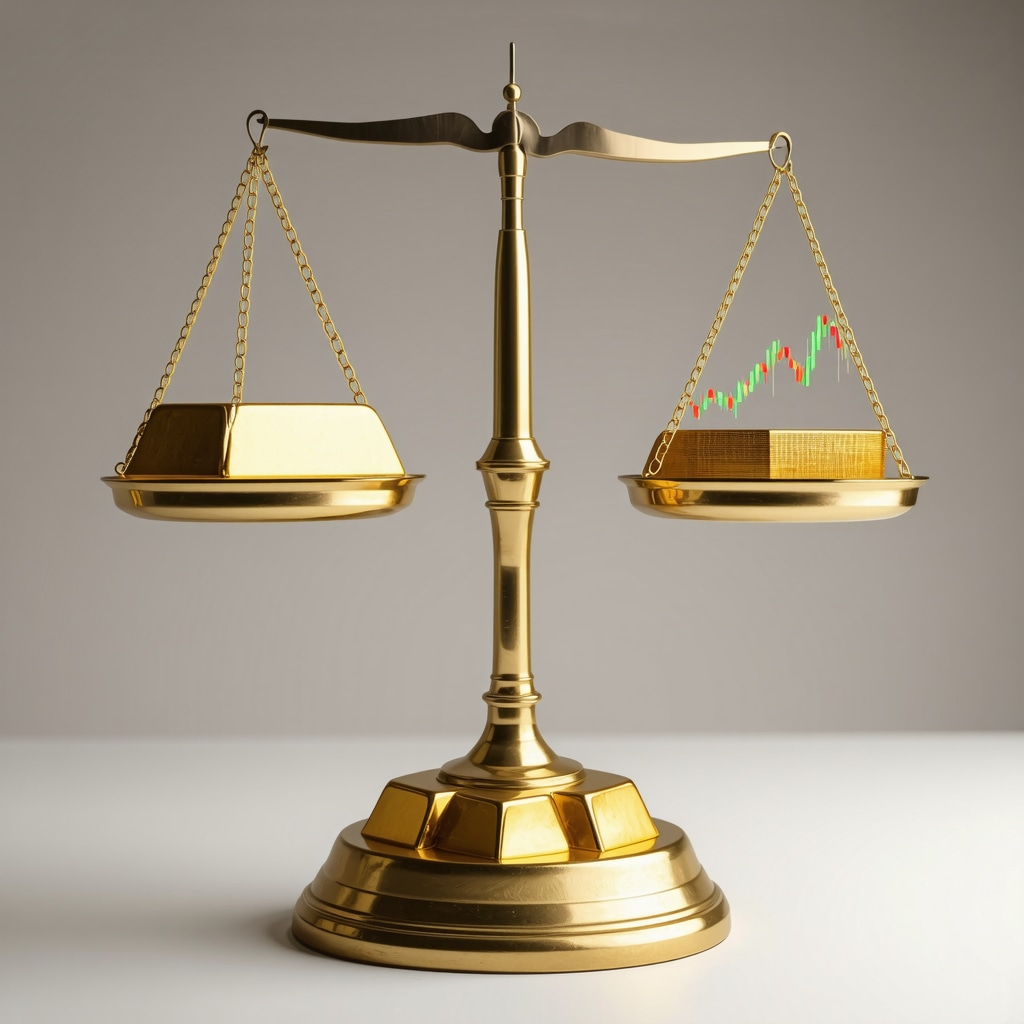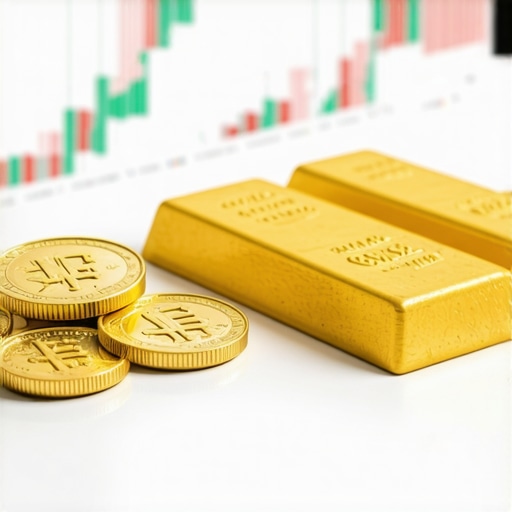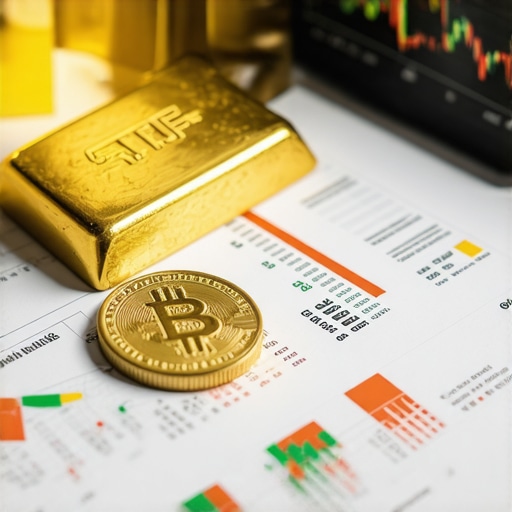Unlocking the Dual Facets of Gold Investment: Stocks or Physical Bullion?
Gold has long been revered as a sanctuary asset, a refuge amidst financial storms. Yet, when contemplating gold investment, the choice between gold stocks and physical gold isn’t merely a preference but a strategic decision that shapes portfolio dynamics profoundly. Understanding the intrinsic advantages and pitfalls of each avenue reveals not just where your capital goes, but how it works for you in varying economic climates.
Golden Tickets or Solid Bars? Decoding the Investment Vehicles
Investing in gold stocks means buying shares of companies that mine or deal in gold, exposing investors to the operational and market risks of those companies alongside gold price fluctuations. Physical gold investment, on the other hand, involves acquiring tangible assets like bullion, coins, or bars, offering direct ownership but with considerations of storage and liquidity.
What Are the Hidden Risks and Rewards of Gold Stocks Compared to Physical Gold?
Gold stocks can yield dividends and potentially greater returns during bullish phases, benefiting from company growth and operational efficiencies. However, they are susceptible to management decisions, geopolitical risks, and market sentiment that can decouple their performance from the underlying gold price. Conversely, physical gold is immune to corporate risks and often serves as a reliable hedge against inflation and currency devaluation, but it lacks yield and incurs costs related to safekeeping and insurance.
Liquidity and Accessibility: Navigating Market Dynamics
Gold stocks typically offer higher liquidity, traded on stock exchanges with ease and speed, enabling swift portfolio adjustments. Physical gold sales might require dealing with dealers or auctions, sometimes at less favorable spreads. Yet, the psychological comfort of holding a tangible asset can provide peace of mind during volatile times—a factor often overlooked in purely financial analyses.
Taxation and Cost Implications: Beyond the Surface
Tax treatment varies significantly: gold stocks often benefit from capital gains tax rules applicable to securities, while physical gold may attract different rates or require meticulous record-keeping for provenance and authenticity. Additionally, premiums on physical gold purchases and potential resale discounts impact overall returns.
For those interested in detailed guidance on acquiring physical gold safely, resources like physical gold investment tips for secure buying provide expert advice.
Strategic Synergy: Blending Physical Gold and Gold Stocks for Optimal Portfolios
A sophisticated approach often integrates both asset types, balancing the stability of tangible gold with the growth potential of equities. This diversification can mitigate risks inherent in either method alone, enhancing resilience against economic uncertainty. For a comprehensive strategy on combining gold stocks and ETFs effectively, explore how to build a balanced portfolio with gold stocks and ETFs.
Expert Insight: The Market Sentiment and Macro Trends Shaping Gold Investments
Recent analyses by industry leaders like the World Gold Council emphasize how central bank policies, geopolitical tensions, and inflation expectations uniquely influence gold’s dual investment forms. Physical demand trends in Asia and emerging markets further complicate price behaviors, underscoring the necessity for investors to stay informed about global gold demand dynamics (World Gold Council Research).
If you found these insights valuable, consider sharing this article with fellow investors or leaving a comment to discuss your experiences with gold stocks versus physical gold. Your perspective enriches the community’s understanding and sharpens collective investment acumen.
Assessing Volatility and Market Timing in Gold Investments
While gold is often touted as a stable asset, its investment vehicles present distinct volatility profiles that investors must evaluate carefully. Gold mining stocks can experience amplified price swings compared to the underlying metal due to operational risks, market sentiment, and broader equity market trends. This introduces an additional layer of volatility, making timing and market analysis crucial for maximizing gains.
Physical gold, conversely, tends to maintain a more stable value, acting as a sanctuary during turbulent markets. However, its price can still be influenced by macroeconomic factors such as inflation rates, currency strength, and geopolitical events. Understanding these nuances aids investors in aligning their gold investment choices with their risk tolerance and market outlook.
How Do Macro-Economic Factors Impact Gold Stocks Differently Than Physical Gold?
Gold stocks are notably sensitive to economic cycles. In a rising economy, mining companies may benefit from enhanced operational efficiencies, increased capital inflows, and higher exploration success rates, which can drive their stock prices beyond the metal’s spot price appreciation. Conversely, during economic downturns, these stocks might underperform due to reduced demand, operational challenges, and tighter credit conditions.
Physical gold’s value, by contrast, is closely tied to its role as a safe-haven asset. Inflationary pressures, currency depreciation, and geopolitical instability typically boost physical gold demand, reinforcing its function as a portfolio hedge. However, factors like changes in central bank policies or shifts in jewelry demand can also influence physical gold prices differently than mining equities.
For investors seeking to deepen their understanding of global gold demand dynamics and their impact on prices, the comprehensive guide on global gold demand trends offers valuable insights.
In What Ways Can Combining Gold Stocks and Physical Bullion Enhance Portfolio Resilience?
Integrating both gold stocks and physical bullion can create a powerful synergy, balancing growth potential with stability. Physical gold serves as a tangible hedge against systemic risks and currency fluctuations, providing a safety net during market downturns. Meanwhile, gold stocks offer opportunities for capital appreciation and dividends, which may outpace bullion gains in bullish phases.
This dual strategy also enables investors to capitalize on varying market conditions — leveraging the liquidity and growth prospects of stocks during favorable periods while relying on physical gold’s steadfast value preservation when uncertainty rises. Additionally, including ETFs or mutual funds specializing in gold can further diversify exposure and enhance liquidity.
Explore strategies on building a balanced portfolio with gold stocks and ETFs to optimize your investment approach.
What Are the Practical Implications of Storage and Security for Physical Gold Investors?
Owning physical gold brings unique considerations beyond market dynamics. Secure storage is paramount to protect against theft, loss, or damage. Options range from home safes to bank safety deposit boxes and specialized vaulting services. Each choice involves trade-offs between accessibility, security, and cost.
Insurance is another critical factor, often incurring additional expenses but providing peace of mind. Investors should also be mindful of provenance documentation and authenticity verification to maintain liquidity and value upon resale.
For detailed advice on safely acquiring and storing physical gold, consult the expert tips found in physical gold investment essential tips for safe buying.
Expert Analysis: How Do Central Bank Gold Purchases Influence Market Trends?
Central banks play a pivotal role in shaping gold market dynamics through their purchasing and selling activities. Their acquisitions can signal confidence in gold as a reserve asset, often driving prices upward. Conversely, sales or reduced buying may exert downward pressure.
Moreover, central bank policies reflect broader macroeconomic strategies related to currency stability and inflation control. Investors monitoring these moves gain critical foresight into potential price trajectories and can adjust allocations accordingly.
For an in-depth exploration of central bank impacts on gold prices, see the analysis at how central bank gold purchases shape market trends.
What Are the Emerging Trends in Gold Investment That Experts Are Watching Closely?
Current expert discourse highlights the growing influence of technological advancements in gold trading platforms, increased institutional participation in gold ETFs, and evolving demand patterns in emerging markets such as Asia and Africa. Additionally, the integration of environmental, social, and governance (ESG) criteria into mining operations is reshaping investor preferences, favoring companies with sustainable practices.
Understanding these trends is essential for sophisticated investors aiming to position their portfolios advantageously.
If you want to stay ahead in gold investment strategy, consider sharing your thoughts or exploring more on effective gold investment strategies for market volatility. Your engagement enriches the collective expertise and sharpens investment acumen.
Harnessing ESG Integration: The New Frontier in Gold Mining Investments
Environmental, Social, and Governance (ESG) criteria have moved beyond buzzwords to become pivotal determinants of investment viability in the gold sector. Investors increasingly scrutinize mining companies for sustainable practices, ethical labor standards, and transparent governance. This shift is not merely ethical but strategic; firms embracing ESG principles often exhibit enhanced operational resilience, lower regulatory risks, and stronger stakeholder trust, translating into more stable long-term returns.
For example, companies adopting innovative water conservation techniques, reducing carbon footprints, and engaging local communities effectively mitigate environmental liabilities and social conflicts, which historically have posed significant financial risks. ESG-conscious investors also benefit from the growing pool of capital dedicated to sustainable assets, boosting liquidity and valuation multiples for compliant gold stocks.
Leveraging Technological Disruptions: From Blockchain to AI in Gold Trading
Technological advancements are revolutionizing gold investment channels, introducing layers of transparency, efficiency, and security previously unattainable. Blockchain technology, for instance, enables real-time provenance tracking of physical gold, ensuring authenticity and reducing fraud risks, a critical concern for bullion investors and dealers alike.
Artificial Intelligence (AI) and machine learning algorithms now facilitate sophisticated market analysis, predicting price movements by assimilating vast datasets including geopolitical events, macroeconomic indicators, and social sentiment. These tools empower traders and portfolio managers to optimize entry and exit points in gold stocks and ETFs with unprecedented precision.
How Does ESG Compliance Affect the Valuation and Risk Profile of Gold Mining Stocks?
ESG compliance acts as a risk mitigant and a catalyst for valuation uplift. Mining companies rated highly on ESG metrics often demonstrate superior risk management frameworks, reducing exposure to environmental fines, social unrest, and governance scandals. This risk reduction typically leads to narrower credit spreads and lower capital costs.
Moreover, ESG-focused investors are willing to pay premiums, reflected in higher price-to-earnings ratios and improved access to capital markets. Consequently, integrating ESG analysis into due diligence processes is indispensable for discerning investors seeking to enhance portfolio quality and sustainability.
According to the MSCI ESG Investing Framework, companies with robust ESG profiles have exhibited lower volatility and higher return stability, underscoring the financial materiality of ESG factors in gold equities.
Institutional Inflows and Their Implications on Gold Liquidity and Price Dynamics
The surge in institutional participation, notably through gold ETFs and futures markets, has significantly altered liquidity landscapes and price discovery mechanisms. Large-scale inflows can amplify price movements, sometimes decoupling gold stocks from physical gold prices due to differentiated demand drivers.
Understanding these dynamics is crucial for investors aiming to navigate short-term volatility versus long-term value. Institutional investors often deploy algorithmic trading strategies, increasing intraday price swings but also enhancing market depth.
For a nuanced understanding of market microstructure changes wrought by institutional activity, refer to CFA Institute’s analysis on institutional investment and liquidity.
If you are keen to dive deeper into cutting-edge gold investment strategies, consider subscribing to our expert newsletter or joining our upcoming webinar series. Engage with leading analysts and refine your approach to gold portfolio management in an evolving market landscape.
Integrating ESG Factors: A Paradigm Shift in Gold Mining Investment Analysis
In the evolving landscape of precious metals investing, Environmental, Social, and Governance (ESG) considerations have transitioned from peripheral concerns to core evaluative criteria. Gold mining companies adhering to stringent ESG frameworks demonstrate enhanced operational robustness, reduced regulatory risks, and improved stakeholder relations, which cumulatively contribute to superior risk-adjusted returns. This strategic integration aligns with the increasing allocation by sustainable funds towards mining equities that proactively manage environmental liabilities and social license to operate.
Technological Innovations Reshaping Gold Trading and Investment Transparency
Emerging technologies such as blockchain and artificial intelligence have begun to redefine the modalities of gold investment. Blockchain’s immutable ledger capabilities enable unparalleled traceability and authentication of physical bullion provenance, mitigating counterfeiting risks and fostering investor confidence. Concurrently, AI-powered analytical models assimilate complex macroeconomic datasets, geopolitical developments, and market sentiment to refine predictive accuracy for gold price movements and optimize trade execution strategies in equities and ETFs.
How Does ESG Compliance Influence Gold Mining Stocks’ Valuation and Risk Metrics?
ESG compliance materially impacts the valuation paradigms and risk profiles of gold mining entities. Companies with exemplary ESG ratings frequently encounter fewer environmental litigations and social disputes, thereby stabilizing cash flows and mitigating downside volatility. This risk mitigation translates into lower capital costs and premium market valuations. The MSCI ESG Investing Framework substantiates that mining firms with high ESG scores consistently outperform peers in terms of return stability and reduced drawdowns, underscoring ESG’s financial materiality within this sector (MSCI ESG Investing Framework).
Institutional Capital Inflows: Transforming Gold Market Liquidity and Price Discovery
The influx of institutional capital, particularly through gold exchange-traded funds (ETFs) and futures contracts, has markedly enhanced market liquidity and altered traditional price discovery mechanisms. These sizeable inflows can induce amplified price volatility and occasionally decouple the performance of gold stocks from physical bullion due to divergent investment motives. Institutional investors’ deployment of algorithmic and high-frequency trading strategies further accentuates intraday volatility while deepening market depth and efficiency.
Understanding these institutional dynamics is imperative for investors aiming to navigate the juxtaposition of short-term price fluctuations and long-term value preservation. The CFA Institute provides an incisive analysis on how institutional investment reshapes liquidity and market microstructure (CFA Institute’s Analysis on Institutional Investment and Liquidity).
For those seeking to elevate their expertise and access actionable insights on sophisticated gold investment frameworks, consider subscribing to our expert newsletter or registering for our forthcoming webinar series. Engage directly with leading market analysts and refine your strategic approach to gold portfolio construction amidst an increasingly complex investment environment.
Frequently Asked Questions (FAQ)
What are the primary differences between investing in gold stocks versus physical gold?
Gold stocks represent equity ownership in mining companies or gold-related businesses and are subject to corporate, operational, and market risks in addition to gold price fluctuations. Physical gold offers direct ownership of the metal as bullion, coins, or bars, providing a tangible hedge against inflation and currency risks but without yield and with considerations for storage and liquidity.
How does ESG compliance influence the valuation and risk profile of gold mining companies?
Companies with strong Environmental, Social, and Governance (ESG) practices typically experience fewer environmental fines, social conflicts, and governance issues, which reduce operational risks and volatility. This risk mitigation often results in higher valuations, lower capital costs, and improved access to investment capital, making ESG compliance a critical factor in assessing gold mining stocks.
Why is combining gold stocks and physical bullion considered a strategic approach in portfolio management?
Integrating both asset types balances growth potential with stability: physical gold acts as a safe-haven asset during market turbulence, while gold stocks offer dividend income and capital appreciation in bullish markets. This synergy diversifies risks and enhances portfolio resilience against economic uncertainties.
What role do central bank gold purchases play in influencing gold prices?
Central banks’ buying and selling activities signal confidence or caution in gold as a reserve asset, directly impacting demand and price movements. Their policies reflect broader macroeconomic strategies affecting currency stability and inflation, providing investors with critical market insights.
How do technological innovations like blockchain and AI impact gold investment transparency and trading?
Blockchain enables secure provenance tracking of physical gold, reducing fraud and enhancing investor confidence. Artificial Intelligence leverages complex datasets to predict price trends and optimize trading strategies in gold stocks and ETFs, improving decision-making precision and market efficiency.
What are the key tax considerations when investing in physical gold versus gold stocks?
Gold stocks generally fall under securities taxation regimes, often benefiting from capital gains tax rates. Physical gold may be taxed differently, sometimes at higher rates or with special rules requiring documented provenance. Additionally, premiums and resale discounts on physical gold affect net returns, necessitating careful tax planning.
How does market volatility differ between gold stocks and physical bullion?
Gold stocks tend to exhibit higher volatility due to operational risks, equity market trends, and company-specific factors. Physical gold typically maintains steadier value as a safe haven, though it remains sensitive to macroeconomic events such as inflation and geopolitical tensions.
What storage and security measures should physical gold investors prioritize?
Secure storage options include home safes, bank safety deposit boxes, and specialized vault facilities, each with trade-offs regarding accessibility, cost, and security. Insurance is advisable to protect against theft or loss, and maintaining authenticity documentation ensures liquidity and value upon resale.
How do institutional inflows affect gold market liquidity and price dynamics?
Institutional participation through ETFs and futures enhances market liquidity but can also increase price volatility and occasionally decouple gold stocks’ performance from physical gold. Algorithmic trading by institutions amplifies intraday price swings while deepening market depth and efficiency.
What emerging trends should investors watch in gold investment?
Key trends include increased ESG integration in mining operations, growing institutional ETF participation, technological advances in trading platforms, and shifting demand patterns in emerging markets like Asia and Africa. Staying informed on these developments helps investors position portfolios advantageously.
Trusted External Sources
- World Gold Council – Provides comprehensive research on global gold demand trends, investment strategies, and market dynamics, offering invaluable data and insights for informed gold investing decisions.
- MSCI ESG Investing Framework – Offers rigorous ESG ratings and analytics that elucidate how ESG factors impact valuation and risk profiles of gold mining companies, critical for sustainable investment approaches.
- CFA Institute Research – Delivers in-depth analyses on institutional investment impacts, market liquidity, and microstructure changes, essential for understanding evolving gold market mechanics.
- BuyingGoldNow.com – Features expert guides on practical aspects of physical gold acquisition, storage, and portfolio integration with stocks and ETFs, supporting actionable investor knowledge.
- Academic Journals on Precious Metals and Finance – Publish peer-reviewed studies on gold price drivers, investment behavior, and technological disruptions, underpinning evidence-based strategies.
Conclusion
Investing in gold demands a nuanced understanding of the distinct characteristics and interplay between gold stocks and physical bullion. While physical gold offers a tangible, inflation-resistant asset shielded from corporate risks, gold stocks provide avenues for growth, dividends, and market participation influenced by operational and macroeconomic factors. Incorporating ESG criteria enhances the sustainability and risk profile of mining equities, reflecting a paradigm shift toward responsible investing. Moreover, technological innovations and institutional capital flows continue to transform gold markets, necessitating agile, informed strategies.
Blending these elements into a coherent portfolio strategy fosters diversification, liquidity, and resilience amid economic volatility. By leveraging authoritative research, recognizing emerging trends, and applying prudent storage and tax considerations, investors can optimize gold’s role as both a strategic hedge and growth vehicle.
Empower your investment journey by sharing these insights, engaging with expert communities, and exploring further expert content to refine your gold investment approach for enduring success.










